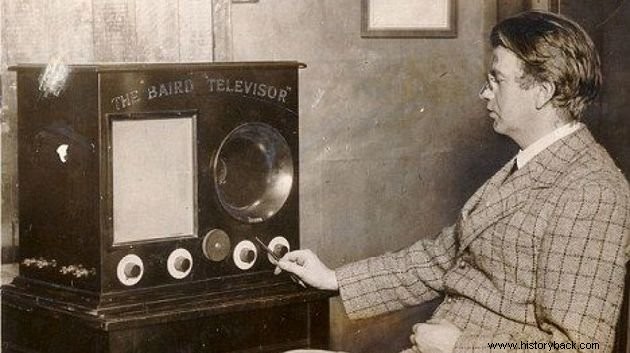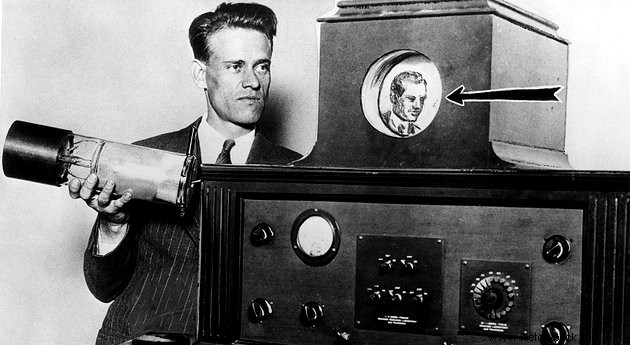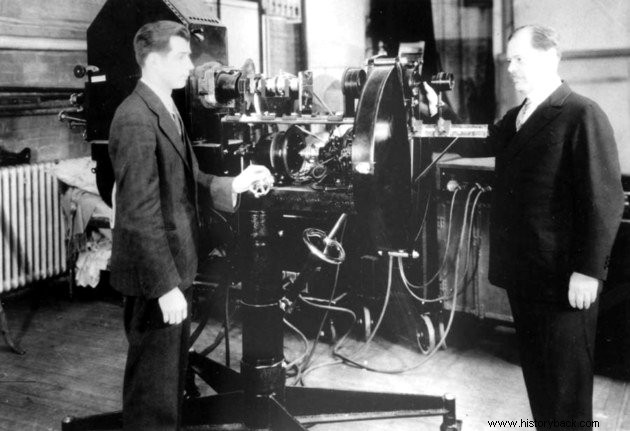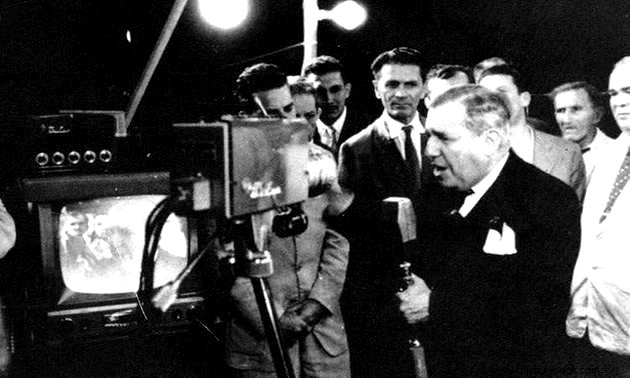The creation of the television apparatus is the result of the combination of several inventions that made possible the reception of an electrical signal and its transformation into images.
Officially, the first demonstration of the device took place in 1926, when Scotsman John Logie Baird introduced mechanical television to scientists at the British Academy.
On the other hand, in the United States, Philo Taylor Farnsworth, in 1927, demonstrated an artifact that transmitted images through cathode rays.
Evolution of Television History
Like photography and cinema, television is the result of several inventions that, together, resulted in the television.
The emergence of radio, telephone and electricity, aroused the will of scientists and the curious to make a machine capable of transmitting images through sound waves.
Let's look at some of these pioneers.
John Logie Baird (1888-1946)
Scottish engineer John Logie Baird (1888-1946) was one of the first to wonder how images could be transmitted over radio waves.
After intense work, Baird demonstrated the device in 1926 for scientists at the British Academy in London.

His mechanical television model was adopted by the BBC and became one of the first to be used. Equally, he managed to perform a color transmission.
In 1937, however, the BBC decides to change the system and starts using the technology developed by the Marconi-EMI company. This decision would leave Baird very shaken, which explains his oblivion in the history of television.
Philo Taylor Farnsworth (1906-1971)
The American Philo Taylor Farnsworth took advantage of the research and creation of the cathode ray tube to obtain the transmission of images by electronic means.

His invention would be successfully tested in 1927 and Farnsworth would show its workings throughout the 1930s at science fairs.
After disagreements with major companies in the industry such as RCA and Philco, he would found his own television and radio company from 1938 to 1951.
Ernst Alexanderson (1878-1975)
Following in the footsteps of mechanical television, the Swedish engineer Ernst Alexanderson, however, would depart from the model, judging it impractical. Thus, he continues his research and manages to prove the transmission of images without the need for cables.

Alexanderson made the first public demonstration of his television at the Proctors Theater in New York on January 13, 1928. This TV had a resolution of 24 lines. Just for comparison, a UHD TV currently has 2160 lines of resolution.
Other scientists who also contributed to the invention of television were:
- Russian engineer Vladimir Zworykin (1888-1982);
- the German engineer Klaus Landsberg (1916-1956);
- Polish inventor Paul Julius Gottlieb Nipkow (1860-1940);
- the French engineer Maurice Leblanc (1857-1923).
Popularization of Television
For some years, television was considered the companion of the few, as only wealthy families could afford the very expensive object. An example is the UK, where only 3,000 people owned televisions in the 1930s.
In 1934, the German company Telefuken begins to manufacture the first devices with a cathode ray tube. Two years later, the Berlin Olympics would be televised.
The Second World War brought the research and production of televisions to a standstill. Only at the end of the conflict, the cheaper the device and the emergence of more transmitter channels.
Thus, practically all social classes now have access to television and today, most homes have at least one television.
See also:Cultural IndustryTelevision as a Means of Communication
Television has become an efficient means of transmitting information, with television news, but also entertainment programs, such as auditorium, children's, soap operas, among others.
In addition to transmitting news and distracting the public, TV presents a large number of advertising, as this is the main source of funding for television, which leads the viewer to unbridled consumption.
The alienating programs, on the other hand, bombard the viewer with information of lesser importance. This is all because the main purpose is to obtain profit and high audience ratings.
Note that she acts as an opinion maker, dictating behavior, political, economic interests, etc. From this point of view, television, in addition to transmitting information, transmits ideas and ideals.
See also:MediaHistory of Television in Brazil
The history of television in Brazil begins in the 1950s, when journalist and businessman Assis Chateaubriand, inaugurated the first Brazilian channel, TV Tupi (channel 3), in São Paulo.
Chateaubriand had been to the United States and decided to use his capital and knowledge acquired on the radio and in the newspapers to venture into the world of image.

As there was no satellite transmission, TV Tupi's programming was restricted to the city of São Paulo. However, the following year, the channel would be opened in Rio de Janeiro.
As in other countries, access to this means of communication was initially restricted to a minimum number of people.
However, over the years, television has become so popular that it is currently present in more than 90% of Brazilian households.
Later, other Brazilian channels were created, which are worth mentioning:Globo, Record, Cultura, Bandeirantes, TV Manchete, SBT.
Curiosities
- The first public television network in the world was the German "Fernsehsender Paul Nipkow" created during the Nazi government and operated from 1935 to 1944.
- The final of the World Cup in Brazil, in 2014, was one of the biggest audiences recorded in history, gathering around 1 billion and 100 million spectators.
- Television has several days dedicated to itself such as August 11, day of the patron saint of television, Santa Clara; September 18, National Television Day; and also November 21, World Television Day.
Read more :
- History of Photography
- History of Cinema
- Phone History
- History of Radio
- History and Evolution of Computers
